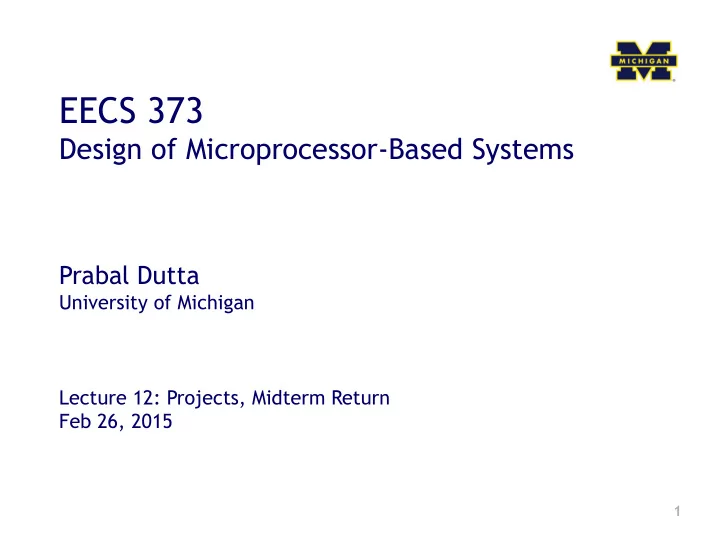

EECS 373 Design of Microprocessor-Based Systems Prabal Dutta University of Michigan Lecture 12: Projects, Midterm Return Feb 26, 2015 1
Sample projects from F ’ 10 and their results • Energy-harvesting sensors à Sensys demo, IPSN paper, TI project, Master ’ s thesis • Wireless AC Power Meter à SURE, IPSN demo, NSF GRFP, SenSys paper, Grad School 2
Research Projects for this Semester • Doorjamb • Fixture Sensors • BLE Ambient Sensors • SensEye 3
Doorjamb An recent research paper proposed "Doorjamb," a system for unobtrusive room-level tracking of people in homes using doorway sensors. From the paper's abstract: "Indoor tracking systems will be an essential part of the home of the future, enabling location-aware and individually-tailored services. However, today there are no tracking solutions that are practical for "every day" use in the home. In this paper, we introduce the Doorjamb tracking system that uses ultrasonic range finders mounted above each doorway, pointed downward to sense people as they walk through the doorway. The system differentiates people by measuring their heights, infers their walking direction using signal processing, and identifies their room locations based on the sequence of doorways through which they pass. Doorjamb provides room-level tracking without requiring any user participation, wearable devices, privacy intrusive sensors, or high-cost sensors." The goal of this project is to design a version of doorjamb using the UM ATUM system, generate the hardware and software needed to be able to build several of these systems, and evaluate the quality of the sensor itself. 4
Fixture Sensors Knowing the position and orientation of everyday fixtures (like kitchen sink handles) in the home allows us to correlate actions like dishwashing, shower use, and toilet flushes with the overall use of resources. This project's goal will be to design and build sensors that are small, and can attach to things like faucet handles, to detect such movements and report them. Starting with the UM Squall platform (see below), this project will design one or more custom daughterboards that fit on the Squall and measure acceleration or gyroscopic motion, and magnetic field, and transmit these values through BLE advertisements to any nearby device that might be interested in receiving the transmissions. The sensor should also timestamp and store the data locally in a circular buffer, thus necessitating the use of an ultralow power real-time clock (RTC) and local storage (e.g. FRAM chip). 5
BLE Ambient Environmental Sensors The goal of this project is augment to BLE tags with a variety of environmental sensors. Starting with the UM Squall platform (see below), this project will design one or more custom daughterboards that fit on the Squall and measure temperature, humidity, light, and pressure periodically and transmit these values through BLE advertisements to any nearby device that might be interested in receiving the transmissions. To demonstrate that this system works, create a simple smartphone library and application showing the transmissions from the sensors. This project will require sensor selection and interfacing, serial communications, embedded driver software, protocol specification and implementation, smartphone software, circuit board design and assembly, and integration skills. The sensors should Conform to the Bluetooth Environmental Sensing Service as appropriate (see below). + + + + Squall 6
SensEye Sighting you eyes with computational glasses. Knowing what one is looking at has tremendous values in retail, real estate, advertising, product design, and other areas. In this project, you will attach two cameras to a pair of glasses, one facing outward (world-facing) and one facing inward (eye-facing). The goal will be to synchronize the image feeds from these two cameras, extract the location of the pupil, and mark where on the world-facing image a person is looking. There will need to be some training to correlate the images from the two cameras. This will require some familiarly with image processing tools (e.g. OpenCV) and low-power imagers. 7
Midterm Statistics • Mean: 66.6% STDEV: 13.5% • Median: 67% High: 92.5% Low: 30% • Worst Problems: #7 (20%), #6 (57%), #5(59%) 8
Midterm CDF 9
Recommend
More recommend